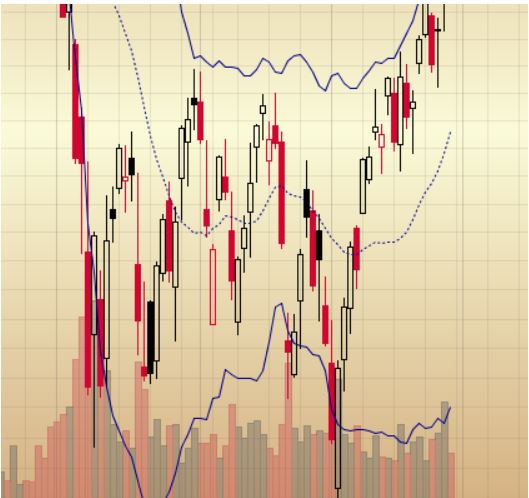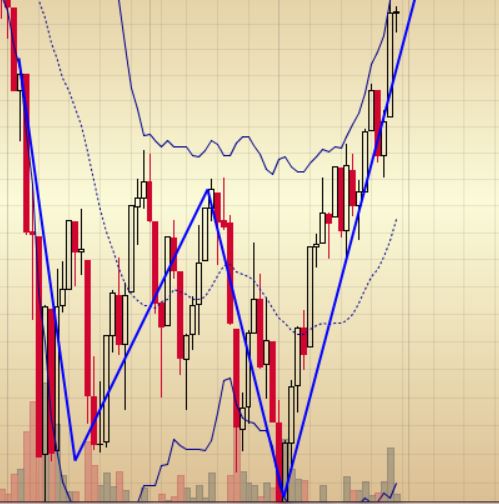Bollinger bands, named for its developer John Bollinger, are measures of volatility shown by bands that are deviations above and below a relevant moving average. The bands expand and contract as volatility increases and decreases. In this article, we’re going to talk about how to use Bollinger bands to find solid trades.
What are Bollinger bands?
 Take a look at this chart on the right; the Bollinger bands are shown in blue.
Take a look at this chart on the right; the Bollinger bands are shown in blue.
The bands are typically calculated from the 20 period simple moving average. This value is shown by the dotted blue line. The upper and lower Bollinger bands are calculated by taking the 20 day simple moving average (standard deviation of price) times 2. (I’ve used the word “period” because one of the great things about Bollinger bands is that they can be used for any time frame.)
Bollinger bands contain 90% of all price action, so it is very useful to know where price lies within the Bollinger band complex. Stocks with price in the top portion of the Bollinger band complex are stronger than stocks with price in the bottom.
I relate price within the Bollinger bands as residing in the penthouse (upper) or the abandoned warehouse (bottom). I want to own penthouse stocks. By watching price movement within the Bollinger band complex, you can easily determine a behavior change in the underlying, thus making it possible to be proactive vs. reactive.
Let’s break that concept down a little bit with a few practical applications.
How to use them to find solid trades
Below is a W bottom, one of the most easily recognized and stable price patterns to trade. A W bottom is a bullish price pattern that forms when price is in a downtrend.
 The left side of the W is formed when price falls to a reaction low – in a lot of cases, it is outside the Bollinger bands. Keeping in mind that the Bollinger band complex contains 90% of the price action, when price violates the Bollinger bands, it usually reverts to the mean price – price goes back into the Bollinger bands.
The left side of the W is formed when price falls to a reaction low – in a lot of cases, it is outside the Bollinger bands. Keeping in mind that the Bollinger band complex contains 90% of the price action, when price violates the Bollinger bands, it usually reverts to the mean price – price goes back into the Bollinger bands.
When this is happening you can see the candle making a very long wick on the bottom. Generally speaking, when you see a long wick after an extreme move, you trade in the opposite direction of the wick. If you catch it forming the wick at the extreme, you have a high probability trade with a target back inside the Bollinger bands.
The middle of the W is formed when price tries to rebound, but is rejected at a prior price level, or a moving average. This is commonly referred to a “dead cat bounce.” The rebound towards the middle Bollinger band typically happens on lowered volume. Usually, the top of the middle is identified with a doji or a spinning top candle, both of which indicate indecision of buyers willing to hold the underlying at or above the current price level.
The right side of the W is formed when price is rejected at the most recent high and falls down toward the bottom Bollinger band to a second reaction low. Confirmation of a true W bottom happens when price attempts to retest the first reaction low, but the real body of the candle stays inside the bands, evidence that the second reaction low was weaker than the first. Again, you can watch the candle formation to see that a wick has formed to the downside, and you can take a high probability trade.
Trade opportunities in a W pattern
There are three trade opportunities within each W formation (refer to the circled areas).
 The reaction low is a high probability trade taken when the candle forms on very high volume with a very long wick at the bottom. Traders can enter the trade when the candle starts to form a real body, no matter what color the candle is. The trade is then maintained with the first target, the price at which the candle is solidly back inside the Bollinger bands. The second target is the middle or top of the Bollinger band complex.
The reaction low is a high probability trade taken when the candle forms on very high volume with a very long wick at the bottom. Traders can enter the trade when the candle starts to form a real body, no matter what color the candle is. The trade is then maintained with the first target, the price at which the candle is solidly back inside the Bollinger bands. The second target is the middle or top of the Bollinger band complex.- The rejection of price at the most recent high (middle or upper Bollinger band) is shown with circle 2. In this example the candle has printed black (black = warning). Black candles form when price closes lower than at open. In addition, candles with longish top wicks often precede the reversal candle. This trade is a little trickier, as you have to wait for confirmation of a top by the next candle, or the next few candles. Traders can enter short with the piercing of the middle band with a target very near the first reaction low. The key to successful rejection trades is not to stay too long. Pick your price target slightly above the bottom Bollinger band and set a buy to cover that is good till canceled as soon as you enter the trade.
- The second reaction low is the candle sequence that forms a higher low, at the right side of the W. This is the most powerful move of the price pattern and is formed on high volume pushing price past prior resistance points. This trade generally goes on to make new highs and is the move that frustrates many traders. Traders can enter long when the price forms a long clear candle that surpasses the prior relative red (sales) candle. This trade is managed by use of a trailing stop, as price generally goes on to make new highs (savvy traders don’t pick tops).
Traders are frustrated by this price pattern, because they experience a draw-down, followed by a bounce, only to draw-down again. A large number of traders buy at the peak of the dead cat bounce and sell at the second reaction low only to watch price rebound and go on to make new highs. In other words, they buy circle 2 and sell circle 3. You can avoid this trap!
By identifying this candle pattern, traders can become aware of the bottoming process and the price action within. Fully aware traders are proactive traders, and proactive traders make controlled, high probability decisions. High probability decisions result in stable portfolio growth.
I challenge you to review your worst trades to see if the W formation was forming at the point you took action. What did you learn?




















